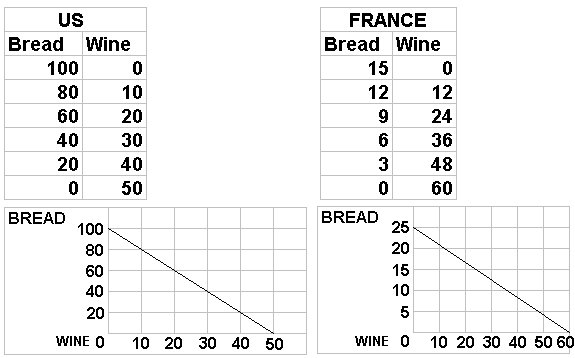
Introduction
Many people who favor trade restrictions (those who oppose free trade) use anecdotal evidence to show that trade can be harmful. An example is the book "America: Who Stole the Dream?" by Donald L. Barlett and James B. Steele (see: http://www.philly.com/packages/america96/). With chapter titles like: "How US Policies Are Costing American Jobs", "Importing Goods, Exporting Jobs", and "Endangered Label: "Made in the U.S.A." it is clear they feel that free trade results in a loss of jobs and is harmful to our economy. Yet, further investigation will show that they support their case only with anecdotal evidence rather than scientific research They interview people who have lost their jobs when their factory moved overseas and state that this is evidence that free trade is harmful. But they ignore much. Trade does cost us jobs, but it also creates jobs. Trade also results in lower prices, more output, and economic growth.
Most economists seem to believe that the benefits of free trade outweigh the costs. Read the following: http://www.ncpa.org/pd/trade/pdtrade/pdtrade10.html. Let's examine the economic basis for trade - or what I prefer to call "specialization and exchange".
The Economic Basis for Specialization and Exchange -- Trade
To better understand why most economists support free trade take this little quiz that was printed in the Wall Street Journal:
|
||
|
If you think like an economist, then you would have answered "A" to all five questions. As we studied in our 5Es lecture, the goal of economic activity is to reduce scarcity and satisfy human wants. Work then is seen as a cost - something that people would avoid if they could. An economy where everybody has to work 18 hours a day is not a success. Imports, where more goods are coming into a country, are seen as a benefit - remember the goal is to get more goods. Exports, where we send our goods to someone else, are seen as a cost - or a loss.
This quiz should remind us that we are studying how to best reduce scarcity.
Why we specialize and exchange?
Trade, either international trade or trade between Illinois and Alabama, or trade between you and Walmart, is based on the efficiencies (i.e. output or boats) gained by specialization.
What would life be like if YOU were self-sufficient? If you produced all you own food, clothes, energy, your house, your car, your computer . . .? What if you didn't buy anything? You would have very little.
But if you specialize (I teach economics) and then buy what you want (exchange) then you will have a much higher standard of living. This is the advantage of specializing and exchanging -- or trade.
advantages:
- larger total output / higher living standards
- lower prices
disadvantage:
- less independence / more interdependence
So we have a choice to make. Either we can join the world economy become more dependent on other countries and enjoy a higher standard of living. Or we can restrict trade and try to "go it alone". We will be more independent, but much more poor.
The basis for specialization and exchange
There are four reasons why specialization and exchange increase our standard of living:
a. differences in resource endowments
b. differences in preferences
c. differences in productivity
d. differences in opportunity costs
Differences in Resource Endowments
The US has much good farmland and Saudi Arabia has much oil and little good farmland. Therefore we can both gain if we sell them wheat and they sell us oil. This reduces scarcity by giving us more satisfaction from the same amount of resources.
Differences in Preferences
Even if two countries have identical resources they my benefit from trade if they have different preferences, Let's assume that the US and Great Britain have identical resources for the production of coffee an tea. So both countries can produce both products. But in the US we prefer coffee and in Great Britain they prefer tea. So we can both achieve more satisfaction from the same amount of resources if we sell them our excess tea and they sell us their excess coffee.
Differences in Productivity
First a few definitions. What is the difference between:
Often the word PRODUCTION means the "quantity produced". For example "the production of cars last year increase 10%"
PRODUCTIVITY is output per unit of resource, usually output per person. If Joe can produce 10 bikes a day and if Jane can produce 20 bikes a day, Jane is more productive than Joe.
PRODUCTIVE EFFICIENCY is producing at a minimum cost (one of the 5Es). So, if Joe can produce 10 bikes a day and if Jane can produce 20 bikes a day, Jane is more productive than Joe. But if Joe gets $10 a day and if Jane gets $40 a day, Who would you hire? Joe is more productively efficient producing bikes at a cost of $1 a bike, whereas Jane produces bikes at a cost of $2 a bike.
Differences in PRODUCTIVITY is a reason that countries benefit from trade. If a country is more productive in producing a product we say that they have an ABSOLUTE ADVANTAGE in producing that product.
A country has an ABSOLUTE ADVANTAGE in the production of a product if it can produce it with fewer resources than another country. Absolute Advantage is the ability to produce a good or service with fewer resources because of greater productivity.
Let's see how differences in productivity (absolute advantage) results in specialization and exchange (trade).
EXAMPLE 1
Let's say there are two people. One is an attorney, the other a mechanic. We could say that the lawyer is more productive at doing law than is the mechanic since he or she can do it in less time. And the mechanic is more productive at fixing cars. so the lawyer has an absolute advantage in law and the mechanic has an absolute advantage in fixing cars. So it doesn't surprise us that if the lawyer's car breaks down he or she will bring it to the mechanic to get it fixed. The lawyer trades with the mechanic.
EXAMPLE 2
Now let's do a numerical example like you will find on the exams.
Below are the production possibilities curves for two countries: the US and France. Notice that we have assumed constant costs so that the curves are straight lines. In a previous lecture we said that PPCs are concave to the origin because all resources within a country are not the same (the law of increasing costs). Here, we assume that all resources in the US are the same so there are constant costs and the PPC is a straight line. The resources in France are also all identical to each other (but different than those in the US) so France also has constant costs and a straight PPC.
Lets begin by assuming that initially there is no trade and each country is self-sufficient - producing all of its own bread and wine. Let's assume that the US choses to produce 40 bread and 30 wine and France produces 9 bread and 24 wine. These amounts are shown on the tables and graphs below.
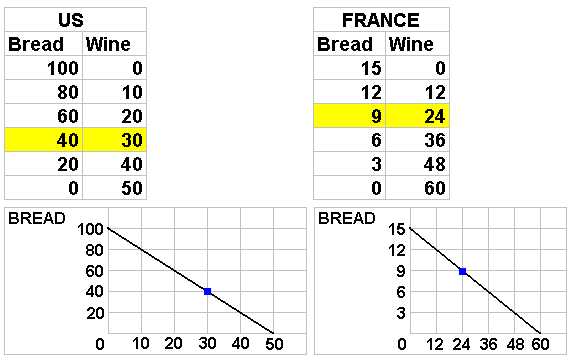
Total production by both countries then is show in the table below: 49 breads and 54 wines. This is just one possible level of total production but it will help us understand how both countries can benefit from trade.
|
BEFORE |
SPECIALIZATION |
EXCHANGE |
||||||||||||||||||||||||||||||||||||
|
|
|
Now, lets assume that each country specializes and produces more of the product in which they have an absolute advantage. This means they produce more of the product in which their resources are more productive. In which product will each country specialize? Looking at the production possibilities tables we can answer this question if we assume that each country has the same amount of resources so the data could represent output per worker. So which country has resources tat are more productive in producing bread? If the US ONLY PRODUCES BREAD it could produce 100 bread and no wine. If France only produces bread it can only produce 15. So the US has an absolute advantage in the production of bread. France can produce a maximum of 60 wines whereas the US can only produce 50. so France's resources are more productive in the production of wine- they have an absolute advantage in the production of wine.
If both countries specialize and produce only those products in which they have an absolute advantage we will get a total production of 100 bread (all produced by the US) and 60 wine (all produced by France). See tables and graphs below.
Now compare total production with specialization according to their absolute advantage with total production before, when they were self sufficient (see table below). You can see that with the SAME AMOUNT OF RESOURCES (remember the assumptions behind the production possibilities curve) MORE IS BEING PRODUCED. Before, when self-sufficient, total production was 49 bread and 54 wine. With 100% specialization we can now produce 100 bread and 60 wines. With the same amount of resources 51 MORE bread is being produced (100 - 49) and 6 MORE wine (60 - 54). This reduces scarcity by producing more output from the same amount of resources.
|
BEFORE |
SPECIALIZATION |
EXCHANGE |
||||||||||||||||||||||||||||||||||||
|
|
|
So specialization results in more output from the same amount of resources, but is each country better off now than before? Probably not. In the US they have plenty of bread to eat but no wine. And in France they are starving (no bread) but they are happy (lots of wine) :-).
Let's see if both countries can gain from exchanging (trade). Let's assume that the US offers the starving French 1 brad for all of their wine. France would probably say no, but they offer the thirsty American's 1 wine for all 100 bread. the US would probably refuse. so they begin to bargain until they find a "trade" that is acceptable to both sides. Let's assume they agree to trade 20 bread for 32 wine.
The graphs below show the results of this exchange. Each country is still PRODUCING as they were before, but now after the trade they are CONSUMING more. In the US after trading 20 breads to France still have 80 left and they received 32 wines leaving France with 28.
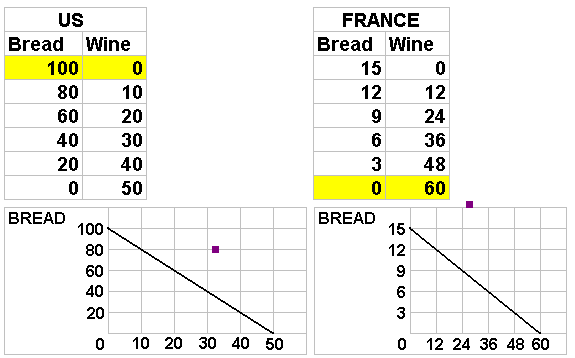
Looking at the graphs above and the table below we can see the gains from trade. The US is now consuming 80 bread and 32 wine. This combination is OUTSIDE their production possibilities curve. In an earlier lecture we said that this was impossible or unattainable. But with trade more can be consumed than if they were self-sufficient. The same is true for France. Both countries then benefit from specializing and exchanging. Both countries can consume quantities that are impossible for them to produce by themselves..
|
BEFORE |
SPECIALIZATION |
EXCHANGE |
||||||||||||||||||||||||||||||||||||
|
|
|
Differences in Opportunity Costs: Comparative Advantage
The main argument in favor of trade is the principle of COMPARATIVE ADVANTAGE.
Comparative advantage is the ability to produce a product at a lower opportunity cost. We defined opportunity cost in an earlier lecture and the value of the next best alternative that is not chosen as the result of a decision.
Let's look at two examples of how this supports trade;
EXAMPLE 1
Assume there is an attorney who is also an excellent auto mechanic and his/her car needs repair. The attorney could fix it in one hour. An auto mechanic could fix it in two hours. (Note: the attorney is better at BOTH fixing cars and doing law.)
Let's say the auto mechanic charges $50 an hour for repairing cars and the attorney charges $200 per hour for doing law.
SHOULD THE ATTORNEY FIX THE CAR OR HAVE THE MECHANIC DO IT? WHY?
If the attorney fixes the car himself/herself it will cost him one hour of lost work in which he could have made $200, but it the mechanic fixes the attorney's car it will only cost the attorney $100 (2 hours x $50). THEREFORE, even if the attorney is better at BOTH fixing cars and doing law, he/she can benefit from specializing in doing law and exchanging with the auto mechanic. This is due to the principle of comparative advantage. To the mechanic the cost of fixing the car himself/herself is greater than the cost of having the mechanic fix it. Since the mechanic can fix the car at a lower opportunity cost, he/she has a comparative advantage in fixing cars and the attorney has a comparative advantage in doing law. Even though the attorney is better, more productive, at both jobs, both the attorney and the auto mechanic can gain from specializing and exchanging (trade).
EXAMPLE 2
Now let's do a numerical example like those you will find on the quizzes and exams.
Look at the production possibilities tables and graphs below for the US and France producing bread and radios. Who has an absolute advantage in producing bread? Since the US can produce 100 loaves if they only produce bread and France can produce only 15, assuming that they have the same amount of resources, the US is more productive in producing bread. the US has an absolute advantage in bread production. Who has an absolute advantage in producing radios? Again it is the US. The US (like the attorney above) is more productive at producing both products.
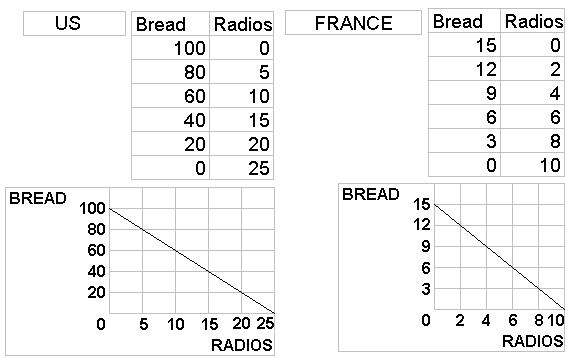
So will they benefit from trading with France? YES! - but which products should they specialize in and trade to the other country? They should specialize according to their COMPARATIVE ADVANTAGES. They should produce more of the product which they can produce for a lower opportunity cost.
So the first thing we have to do is calculate the opportunity costs. This is similar to what we did in a previous lecture.
In the US, when they produce 1 radio, how many breads do they have to give up? Well, if they produce no radios, they can produce 100 bread. but if they produce 25 radios they can't produce any bread. So for 25 radios they have to give up 100 bread OR 4 bread for every 1 radio. In France what is the cost of 1 radios in terms of bread given up? if they produce no radios they can produce 15 bread. If they produce 10 radios they can't produce any bread. So for 10 radios they gave up 15 bread OR 1 and 1/2 bread for 1 radio.
US: 1 radio costs 4 bread
France: 1 radio costs 1 and 1/2 bread
So, who has a comparative advantage in the production of radios? Who can produce radios at a smaller cost? Who can produce radios and give up less bread? The answer is FRANCE. the US has an absolute advantage (more productive) in the production of radios, but France has a comparative advantage. France can produce radios at a lower opportunity cost.
Who has a comparative advantage in the production of bread? Who can produce bread at a lower opportunity cost? Which country gives up fewer radios for each bread produced?

In the US, when they produce 1 bread, how many radios do they have to give up? Well, if they produce no bread, they can produce 25 radios. but if they produce 100 bread they can't produce any radios. So for 100 bread they have to give up 25 radios OR 1/4 radio for every 1 bread. In France what is the cost of 1 bread in terms of radios given up? If they produce no bread they can produce 10 radios. If they produce 15 bread they can't produce any radios. So for 15 bread they gave up 10 radios OR 2/3 (10/15 ) radios for 1 bread.
France: 1 bread costs 2/3 radio
So, who has a comparative advantage in the production of bread? Who can produce bread at a smaller cost? Who can produce bread and give up fewer radios? The answer is the US. The US can produce radios at a lower opportunity cost so they have a comparative advantage in the production of bread.
Self Sufficiency Before Specialization
Let's assume that before specialization and trade both countries produce the quantities shown below. I selected these quantities as our starting point so that I can show that the countries both gain from trade.
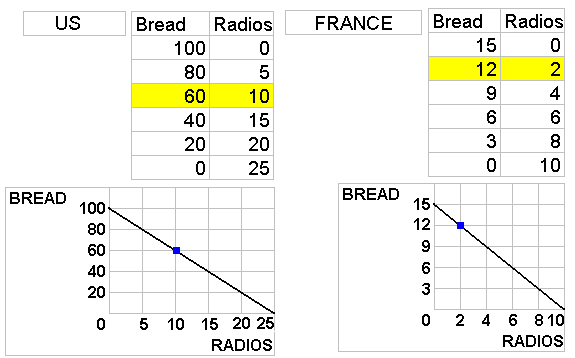
So, total production without trade is 72 bread and 12 radios. See table below.
|
BEFORE |
SPECIALIZATION |
EXCHANGE |
||||||||||||||||||||||||||||||||||||
|
|
|
Specialization
Now, lets assume that each country specializes and produces more of the product in which they have an comparative advantage. We just calculated the opportunity costs and we concluded that the US has a comparative advantage in the production of bread and France has a comparative advantage in the production of radios.
On our exams we'll assume that they specialize 100%, which means each country will only produced one products, but here (as in the real world) we'll have them produce MORE of that product in which they have a comparative advantage but not only that product.
So, the tables and graphs below show the results of this specialization according to the principle of comparative advantage. Notice that the US now is producing more bread than when they were self-sufficient and France is producing more radios than before.
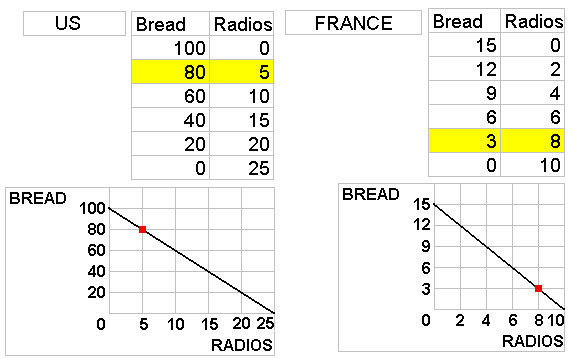
So, total output is now 83 bread and 13 radios. See table below.
|
BEFORE |
SPECIALIZATION |
EXCHANGE |
||||||||||||||||||||||||||||||||||||
|
|
|
Now compare total production with specialization with total production before keeping in mind the assumptions behind the productions possibilities model. These assumptions include "fixed resources", the quantity of resources does not change, but what happens to the amount produced? The amount increases by 11 bread (83 - 72) and 1 radio (13 - 12). So from the same amount of resources we are now producing 11 more bread and 1 more radio. This reduces scarcity.
But are the US and France better off now than before? We can't tell yet, but let's assume they decide to trade. The US produces a lot of bread and few radios and France has a lot of radios and little bread. So the US may offer to trade 1 bread to France for all their radios -- and France will probably decline the offer. France may then offer to trade 1 radio for all of the bread produced in the US -- and the US will most likely refuse.
If they continue bargaining, they may find a trade that is beneficial to each country. Let's say they decide to trade 12 bread for 6 radios.
The US which is producing 80 bread 5 radios (see below) and trading 12 bread to France for 6 radios remains with 68 bread (80 - 12) and 11 radios (5 + 6).
France which is producing 8 radios and 3 bread trades 6 radios to the US in return for 12 bread. They end up with 2 radios (8 - 6) and 15 bread (3 + 12).
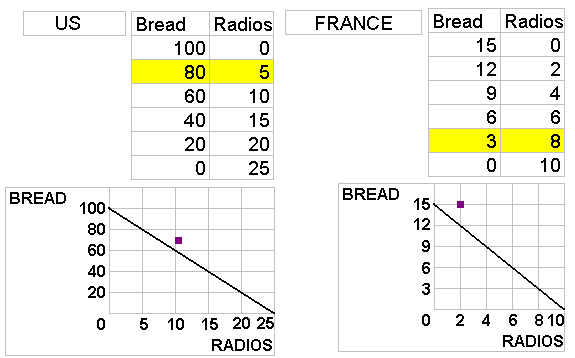
If we plot these quantities on the production possibilities graphs of each country (see above) we see that they lie outside the production possibilities curves of each country. In an earlier lesson we said that these quantities are impossible -- but we should have said "impossible without trade". Both countries are consuming more with trade than they could without trade. This reduces scarcity.
|
BEFORE |
SPECIALIZATION |
EXCHANGE |
||||||||||||||||||||||||||||||||||||
|
|
|
Trade with increasing costs
We have been assuming that there are constant costs in the production proces which gives us a straight line PPC and makes it easier to calculate opportunity costs and to find who has the comparative advantage. But in an earlier lesson we learned about the Law of Increasing Costs. What would happen to our analysis if we used a more realistic concave PPC?
The result would be that trade is still beneficial to both countries, but there would not be 100% specialization. This is because as production of a product increases so does the opportunity costs of producing that product and the country will not retain its comparative advantage. Remember that comparative advantage is the ability to produce a LOWER opportunity cost, so as costs increase with production, the comparative advantage is lost.
But trade is still beneficial.
terms of trade
In the example above we said that after bargaining the US and France decided to trade 12 bread for 6 radios. This is called the "terms of trade" - the prices of goods involved in international trade expressed in real terms (rather than in money terms).
How did I know that if I used these terms of trade that both countries would gain from trade?
It is possible to calculate the minimum and maximum terms of trade. We begin by looking at the opportunity costs:
US: 1 radio costs 4 bread
France: 1 radio costs 1 and 1/2 bread
US: 1 bread costs 1/4 radio
France: 1 bread costs 2/3 radio
W know that since the US has a comparative advantage in the production of bread they will specialize in bread, produce more of it, and trade it to France. What is the minimum amount that the US would accept for 1 bread. Well, in the US itself it costs 1/4 radio to produce each bread so they will not accept anything less than this. France is buying bread from the US. It costs France 2/3 radios to produce 1 bread so they will not pay the US any more than this.
The minimum the US will accept for one bread is 1/4 radio and the maximum that France will pay for 1 bread is 2/3 radio. We say that the minimum and maximum terms of trade for 1 bread that is acceptable to both countries is 1/4 to 2/3 radios.
The ACTUAL terms of trade was 12 bread for 6 radios (see above) or 1 bread for every 1/2 radio. this is between the minimum and maximum terms of trade (1/2 is between 1/4 and 2/3).
We can do the same for radios. France sells radios to the US. It costs France 1 and 1/2 bread to produce 1 radio so they will not accept anything less than this. The US is buying radios. It costs the US 4 bread to produce 1 radio itself, so they will not pay France anything more than 4 bread for 1 radio. Therefore, the minimum and maximum terms of trade for 1 radio is 1 and 1/2 to 4 bread.
The ACTUAL terms of trade was 12 bread for 6 radios (see above) or 1 radio for every 2 bread. this is between the minimum and maximum terms of trade (2 is between 1 and 1/2 and 4).
For review exercices go to: http://www.harper.cc.il.us/mhealy/eco212i/review/revtrade.htm